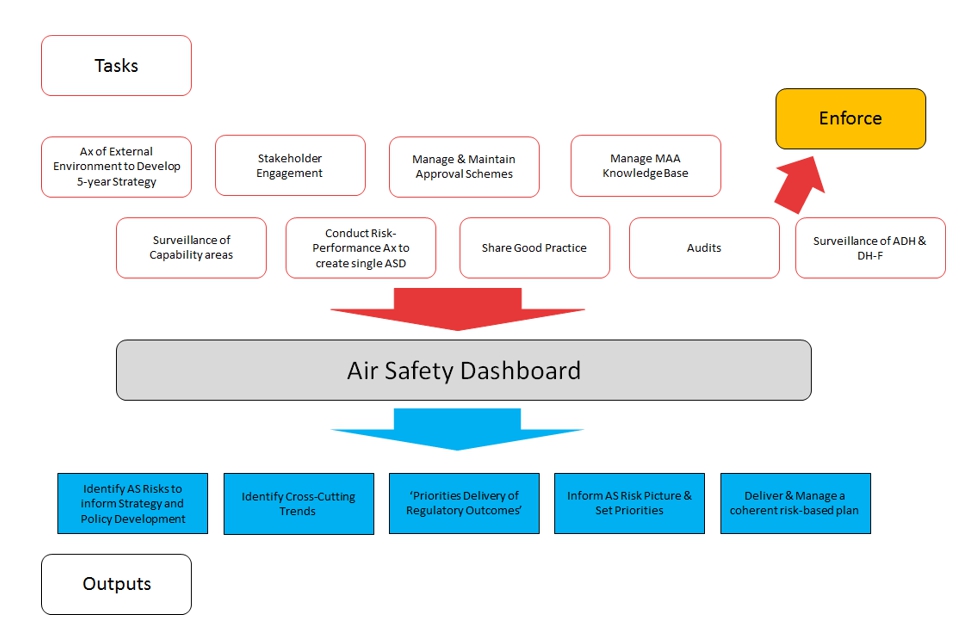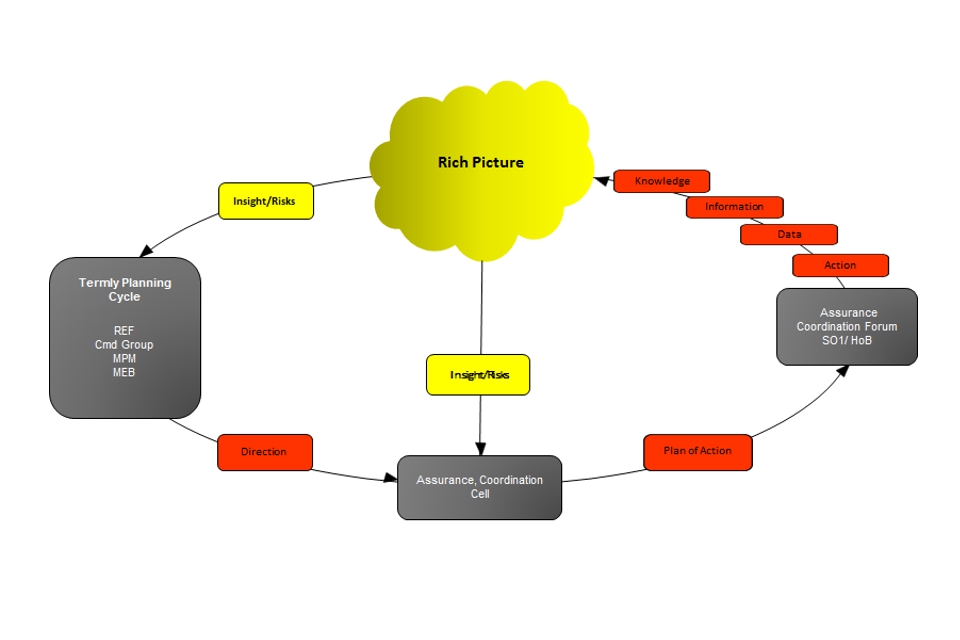Changes to the Military Aviation Authority (MAA) organisational structure and operating model.

Introduction
The establishment of the MAA in 2010, on the recommendations of the Haddon Cave Inquiry, as the single authority responsible for the full and independent regulation and oversight of the entire UK Defence Air Environment (DAE) has delivered significant improvement in military Air Safety including the design, engineering and operating disciplines. However, headlines do not always show the whole picture. Behind safety statistics are incidents, near misses and risk factors that could have the potential to develop into accidents. By building a picture of safety performance across the total aviation enterprise, it is possible to see the full extent of the risks. It also enables better decisions to ensure that the whole DAE is managing those risks effectively. To achieve the MAA's vision to be a world class military Air Safety regulatory and assurance organisation that is proactive, innovative, modern, efficient and effective, there is a continuing need to examine our approach. Like our colleagues in the Civilian Aviation Authority (CAA), the MAA determined that the most effective route is to examine the causal factors in greater detail and transform our regulatory and assurance activities to follow a more risk and performance based approach.
The adoption of this Risk Based Assurance (RBA) approach has involved intelligent targeting of resources to determine a holistic picture of Air Safety across the DAE for the purposes of deciding whether and how to intervene and informing the MAA's longer-term strategies and priorities. This transformational change across our people, processes, systems and mind-set was initiated some two years ago and has been in practice since 2017. However, in keeping with the incremental approach to transformation set out by the Director, the MAA's internal operating model and structural organisation was formally changed in June this year to fully reflect the transformation to the RBA approach.
RBA has improved the sharing of risk information and best practice, but it does not always mean less assurance activity. Understanding the risks across each Air System Enterprise (ASE) has enabled the MAA to compare safety performance more accurately and set off appropriate programmes of action to achieve better outcomes. Adjusting the level of assurance activity, ranging from oversight of Air Systems Safety Working Groups to full multi-disciplinary audits, is based on qualitative analysis of known and emerging risks and safety performance, which generates a Rich Picture and is portrayed through the MAA's internal Air Safety Dashboard (ASD). RBA and the Rich Picture are generating the evidence to identify where poor safety practice exists and allow us to focus more effort in assuring the necessary changes are made. Conversely, we will be able to identify areas where a potential reduction in the intensity of assurance effort is warranted due to clear evidence of good safety performance. Drawing together all such evidence, knowledge and experience about factors that impact an organisation's safety performance enables better decisions about future oversight activity, which can then be delivered in a consistent, targeted and proportionate way.
MAA mission
The MAA's mission is to enhance the delivery of operational capability through Continuous Improvement in military Air Safety, appropriate culture, regulation and practice. Our activities focus on providing assurance that operating Risk to Life (RtL) is managed so that it is As Low As Reasonably Practicable (ALARP) and Tolerable and we are conscious of the part we play in supporting the efficient and effective delivery of UK operational capability. Underpinning all of our activity are guiding principles which form the foundations for individual and organisational behaviours, as well as continuing to influence our strategic thinking.
MAA strategy
The MAA strategy underpins our commitment to improving Air Safety across the DAE. The strategy must influence, shape and inform a rigorous risk based planning process that drives activity. The strategic direction, based on the 2-star vision, aligns the full range of activities that the MAA is required to perform in regulating and providing assurance to the DAE. In order to achieve this, the MAA has identified four Strategic Outcomes and two Enabling Outcomes, supported by 27 Key Conditions as illustrated in Figure 1 below.

The successful delivery of Risk Based Assurance is dependent on five supporting Key Conditions:
Key Condition 2.1. Our assurance process needs to remain credible, where information is available, relevant and manageable and where staff are trained to an independently acknowledged standard.
Key Condition 2.2. The MAA can become a true 3rd Party Assurance (PA) organisation only by working with recognised and empowered 2 PA organisations. 2PA activity conducted by organisations must be sufficiently robust to permit the MAA to operate at the level of an independent party. It requires structural agility and appropriate resourcing of 2nd PA to optimise the MAA 3rd Party governance and planning processes.
- Key Condition 2.3. Is driven by intelligence and analysis of the organisation that is under review, facilitating effective use of MAA resource and minimising the burden on the Regulated Community (RC). Risk based processes will continue to be developed and refined to assist in effective resource management, allowing our attention to be focussed on higher-risk/higher-impact areas or those with potential of introducing greater risk.
- Key Condition 2.4. Since the MAA was established, much of our activity has been focussed on approving organisations under the various approval schemes. As these schemes continue to mature, our focus will transition from initial compliance based reviews to how well these organisations have established themselves through use of the risk based assurance programme.
- Key Condition 2.5. To ensure that an Air System's design meets appropriate safety requirements, a systematic, independent certification process is provided for both new types of military registered Air Systems and for major changes to existing designs.
In order to determine the most appropriate means of achieving these objectives, several inter-connected work strands, including a Value Stream Analysis and Organisational Safety Assessment, were conducted between November 17 and April 18. They recommended changes to the Authority's operating model and organisational structure to facilitate full implementation of RBA. To ensure that the assurance process remains credible as the RBA process and improved ways of working are refined, the MAA adopted a phased transformation to the new operating model. An Initial Operating Capability (IOC) was declared on 12 June 18, with Full Operating Capability (FOC) Phase 2 being expected by June 19, via an interim FOC Phase 1 in December 18. For the RC, revised e-mail addresses from 1 Oct 18 are likely to be the first external sign of the changes.
Revised organisational structure
Changes to the MAA's organisational structure involve a reduction from three to two 1-Star headed Groups and is captured in Figure 2. This has been achieved by the merger of Analysis (Ax) and Plans, and Oversight and Approvals (O&A) into a single Operating Assurance Group (OAG). The plans role is now incorporated within the Chief Of Staff (COS) Division, which provides the key enabling function across the MAA. Regulations and Certification remain broadly unchanged, but with a more specialized role for International Engagement and Recognition to be led by a B1 Deputy Head who will have reporting responsibility for the Design Approved Organisation Scheme (DAOS) Branch, which will maintain close functional links with all OAG activity.
The OAG is led by the 1-Star Head Operating Assurance (formerly Head Oversight and Approvals). It consists of three OF5s: Deputy Head Operating and Deputy Head Engineer are responsible for conducting assurance activity across the DAE, with Deputy Head Test, Evaluation and Special Tasks (TEST) responsible for special projects and is the MAA Subject Matter Expert (SME) for test and evaluation. They are supported by 10 specialist branches, each led by an OF4/B1 Head of Branch (HoB).

An Assurance and Coordination Cell (ACC), consisting of three SO1s representing the Operating and Engineering Divisions and COS Plans, coordinates, prioritises and resources activity and facilitates inter-Group and pan-Branch communication. This is executed through the Assurance Coordination Forum (ACF) held on a fortnightly basis.
Operating model
The operations of the MAA continue to be overseen by the MAA Executive Board (MEB), chaired by the Director MAA. Membership includes the MAA 2-Star Director (Technical) and the two 1-Star Heads. They are responsible for directing the organisation, setting strategy and prioritising outputs to ensure delivery of MAA strategic and regulatory outcomes. The revised operating model seeks to ensure that the MAA Rich Picture is more robustly informed, analysed and communicated in line with the intent to functionally ensure 'Safe to Operate' and 'Operating Safely' principles. A robust battle rhythm, structured around the Termly Planning Cycle (TPC) will ensure enhanced and structured internal MAA communications and reduce MAA 'stove-piping'. The TPC commences with the Risk Exposure Forum (REF), providing focused analysis, which informs the MAA Planning Meeting, which prioritises assurance activity identified in the REF, culminating with the MEB, and, finally, the external Duty Holder facing MAA Operators Council (MOC) and the Joint Air Safety Committee (JASC). The functional outputs of the OAG, detailed in Figure 3, are continuous and influence each component of the TPC.

Rich picture
The Rich Picture is a significant factor in achieving full RBA; it utilises a system similar to the 'Intelligence Cycle' (Collection, Processing, Dissemination, Direction) and is illustrated at Figure 4. It brings together all intelligence drawn from analysis of the DAE, in order to present the overall level of Air Safety risk and to provide a measure of regulated organisations' performance. Thereby the Rich Picture provides the evidence behind the prioritisation of the MAA's resource. It also facilitates coordination of activities, thus achieving efficiencies for both the MAA and the RC. Hence a robust and continually updated Rich Picture is fundamental to MAA understanding of pan-DAE risk exposure and performance. A fully informed, understood and communicated Rich Picture is dependent upon appropriate IT tools and the continued development of the ASD.

Benefits
The restructuring of the MAA, the creation of the OAG and adoption of the new operating model is designed to deliver the following benefits:
Improved communication across the two Groups and between the Operating Assurance Branches, leading to less duplication and a more coherent approach to assurance activity.
Better intelligence, evidence gathering and analysis to generate a Rich Picture and a holistic understanding of risk in the DAE.
Increase MAA reach into areas that previously have been un-resourced thus adding to the Rich Picture. The change has also enabled the MAA to develop end-to-end assurance themes as a result of better coordination of activity.
Generation of multi-disciplinary assurance teams to better reflect the more integrated requirements of RBA as a series of cross-cutting activities.
Continual Improvement, together with refinement of the risk based approach through to FOC in June 2019, will help identify and reinforce best practice and allow the MAA to target resources strategically to the areas with the greatest potential to deliver the best safety outcomes.






